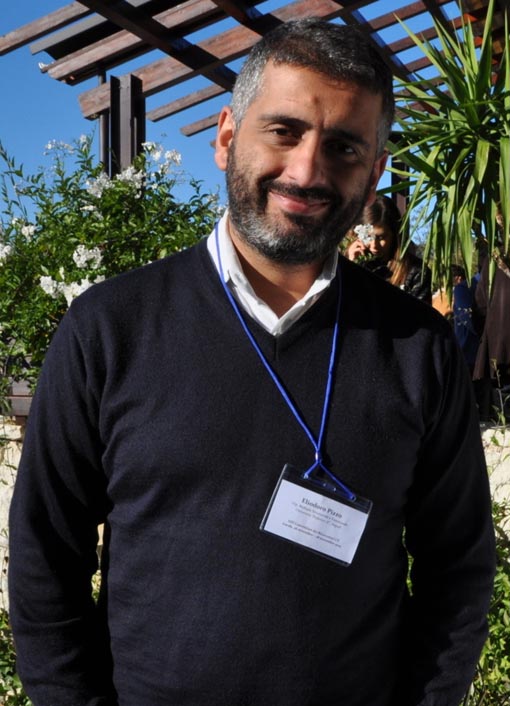Developed skills and lines of research
Eliodoro Pizzo graduated in 2001 with a degree in Biological Sciences, specializing in Biomolecular Sciences, from the University of Naples Federico II. Since March 2009, he has been a university researcher at the Department of Structural and Functional Biology at the same university and confirmed in this role in 2012 in the Structure and Function of Proteins Laboratory (SFP). His specific area of research primarily involves antimicrobial peptides, with applications in cystic fibrosis to control lung infection/inflammation. He is currently an Associate Professor of Biochemistry at the University of Naples Federico II.
Projects funded by FFC Ricerca as Principal Investigator or as Research Manager
FFC#16/2017
Pre-clinical effectiveness of three human cryptic antibiofilm peptides (GVF27, HVA36 and IMY47): efficacy against lung pathogens and studies in animals
FFC#20/2014
Identification and characterization of LPS-neutralizing human peptides: potential tools to control inflammation in cystic fibrosis lung disease
FFC#9/2012
Development, production and characterization of antibacterial peptides (CAMPs) active on the sessile form of the opportunistic human pathogens Pseudomonas aeruginosa and Burkholderia cenocepacia
FFC#15/2011
Development, production and characterization of antibacterial peptides (CAMPs) active on the sessile form of the opportunistic human pathogens Pseudomonas aeruginosa and Burkholderia cenocepacia
Projects financed by FFC Ricerca as a partner
FFC#18/2018
In vitro and in vivo efficacy of an antimicrobial and antibiofilm designed peptidomimetic against CF lung pathogens
Publications from FFC Research projects
- Pizzo E, Zanfardino A, Di Giuseppe AM et al. A new active antimicrobial peptide from PD-L4, a type 1 ribosome inactivating protein of Phytolacca dioica L.: A new function of RIPs for plant defence? FEBS Lett. 2015 Sep 14;589(19 Pt B):2812-8. doi: 10.1016/j.febslet.2015.08.018. Epub 2015 Aug 20.
- Notomista E, Falanga A, Fusco S, et al. The identification of a novel Sulfolobus islandicus CAMP-like peptide points to archaeal microorganisms as cell factories for the production of antimicrobial molecules. Microb Cell Fact. 2015 Sep 4;14:126. doi: 10.1186/s12934-015-0302-9.
- Pane K, Sgambati V, Zanfardino A et al. A new cryptic cationic antimicrobial peptide from human apolipoprotein E with antibacterial activity and immunomodulatory effects on human cells. FEBS J. 2016 Jun;283(11):2115-31. doi: 10.1111/febs.13725. Epub 2016 Apr 20.
- Pane K, Durante L, Pizzo E, et al. Rational Design of a Carrier Protein for the Production of Recombinant Toxic Peptides in Escherichia coli. PLoS One, 2016 Jan 25;11(1):e0146552. doi: 10.1371/journal.pone.0146552. eCollection 2016.
- Pizzo E, Cafaro V, Di Donato A, Notomista E. Cryptic Antimicrobial Peptides: Identification Methods and Current Knowledge of their Immunomodulatory Properties. Curr Pharm Des. 2018;24(10):1054-1066. doi: 10.2174/1381612824666180327165012.
- Pane K, Cafaro V, Avitabile A, et al. Identification of Novel Cryptic Multifunctional Antimicrobial Peptides from the Human Stomach Enabled by a Computational-Experimental Platform. ACS Synth Biol. 2018 Sep 21;7(9):2105-2115. doi: 10.1021/acssynbio.8b00084. Epub 2018 Aug 20.
- Andrea Bosso, Rosa Gaglione, Siepi Maria Luisa, Valeria Cafaro, Eugenio Notomista, Angela Arciello, Eliodoro Pizzo. Pre-clinical effectiveness of three human cryptic antibiofilm peptides (GVF27, HVA36 and IMY47): efficacy against lung pathogens and studies in animals. The Proceedings of the 16th Italian Convention of Investigators in Cystic Fibrosis. Multidisciplinary Respiratory Medicine, 2019, 14 (Suppl 1):5

